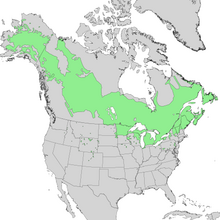Balsam Poplar
| Balsam Poplar | ||||||||||||
|---|---|---|---|---|---|---|---|---|---|---|---|---|

Balsam Poplar ( Populus balsamifera ) |
||||||||||||
| Systematics | ||||||||||||
|
||||||||||||
| Scientific name | ||||||||||||
| Populus balsamifera | ||||||||||||
| L. |
The balsam poplar ( Populus balsamifera , synonym : Populus tacamahaca ) is a tree from the section of the balsam poplar ( Tacamahaca ), which can be found throughout northern North America. It is the northernmost deciduous tree in the New World .
description
The balsam poplar is a tall, fast-growing tree and reaches a height of 18 to 24 meters, up to a maximum of 36 meters. It has a continuous trunk and rising branches. The shoots are terete or somewhat angular and hairy. The winter buds are large, up to 2.5 inches long, and covered with yellow, fragrant resin. The leaves are alternate, ovate to broadly ovate, coarse, pointed and rounded to heart-shaped at the base. They are serrated and finely ciliated. They become 5 to 12 inches long. The top of the leaf blade is bare and dark green, the underside is whitish and slightly hairy. The stem is thin, round and 3 to 5 inches long. Like all poplars, the balsam poplar is dioecious and wind-flowered and forms pendulous catkins . The female flowers have two-leaved ovaries , the male catkins are 5 to 7 centimeters long and have 12 to 15 stamens . The fruits are leathery capsules that open with two flaps and appear in catkins that are 12 to 14 centimeters long. It has a chromosome number of 2n = 38.
Distribution and location requirements
The balsam poplar is the northernmost deciduous tree in the New World. Its range extends from Newfoundland and Labrador along the tree line to northwest Alaska , and south to southeast British Columbia , Iowa and Pennsylvania . Local occurrences are found in the Rocky Mountains , which extend to Colorado in the south , and in West Virginia in the east . In Central Europe you can occasionally find it as a park tree, less often it is used in forestry.
The balsam poplar is a common tree. It grows in floodplain and bank trees, mostly in river valleys, on lake shores and on the edge of swamps, on fresh to moist, slightly acidic to alkaline soils made of sand, gravel and gravel. It loves warmth and prefers sunny locations, but is frost hardy. It is a type of winter hardiness zone 3, so it can withstand mean annual minimum temperatures of −35 to −40 ° C. In the Rocky Mountains it reaches heights of up to 1670 meters above sea level.
ecology
The balsam poplar grows in pure stands or together with the American quivering poplar ( Populus tremuloides ), the paper birch ( Betula papyrifera ), the balsam fir ( Abies balsamea ) and the white spruce ( Picea glauca ).
Systematics
In addition to the nominate form, there is also the variety Populus balsamifera var. Subcordata , which is also called Ontario poplar. Their range extends from Newfoundland to Ontario and south of Michigan to New York . The leaves of the variety are larger and broadly ovate to triangular, the petiole is hairy.
use
→ Main article: Poplar wood
proof
literature
- Andreas Roloff , Andreas Bärtels: Flora of the woods. Purpose, properties and use. With a winter key from Bernd Schulz. 3rd, corrected edition. Eugen Ulmer, Stuttgart (Hohenheim) 2008, ISBN 978-3-8001-5614-6 , pp. 461-463.
- Schütt, Schuck, Stimm: Lexicon of tree and shrub species . Nikol, Hamburg 2002, ISBN 3-933203-53-8 , pp. 395 .
Individual evidence
- ↑ a b Roloff et al .: Flora of the Woods
- ↑ a b c d e Schütt et al .: Lexicon of tree and shrub species

